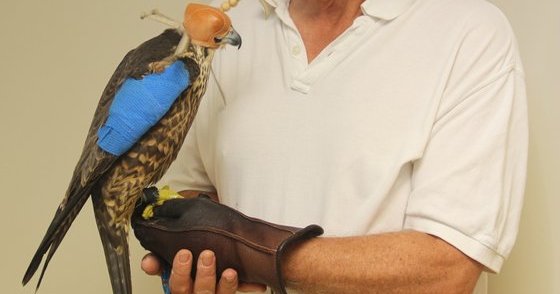
THIS STORY IS FROM OUR ARCHIVES
Maurice is fascinated by birds of prey. He admires their strength, skill and flying ability, and he has an aviary at home where he keeps a tame male falcon that he uses for his hobby of falconry. People in the area know about his interest, so whenever a bird of prey is found in difficulties, he’s often contacted to help out.
PERRY WAS FOUND HELPLESS BESIDE THE ROAD
A man walking his dog found Perry beside the road, near the edge of a County Wicklow village. The bird could not fly, so it was obvious that she needed help. The man who found her knew nothing about falcons, and he could not even catch the bird, so he telephoned Maurice. Maurice loaded up his bird equipment: a cage, a net and some large gloves, and he headed down to the area. The bird was easily caught, and a quick physical check over confirmed that there were no life threatening injuries. Maurice brought her home and kept her in a darkened area overnight so that she was not over stressed. He then brought her in to our clinic the following morning so that we could work out what was wrong with her and how she could be helped.
It was obvious that there was something wrong with her right wing: she could not extend it fully, and it drooped rather than being held in the normal position. I gave her a short anaesthetic then took some x-ray pictures. These showed exactly what had happened: the bird had been targeted with a shot gun, with small white spherical objects signifying shotgun pellets showing up clearly on the x-ray. The pellets had caused damage to her muscles and soft tissues, but there was a more serious problem: one of the main bones in her wing had been fractured.
The bones of a bird’s wing are the same as a human arm, and the damaged area was the equivalent of the human forearm. There are two bones running parallel to each other here: the radius and ulna, connecting up the elbow to the wrist. If both of these bones had been fractured, the falcon would have had to be euthanased, as she would have been unable to fly again. She was fortunate: only her ulna was fractured. This meant that her radius was still intact, and this could act as a natural splint to hold the ulna stable while it healed. If we simply placed her wing in a sling for 4 to 6 weeks, there was a good chance that she’d be able to fly again.
PERRY HAD TO WEAR A SLING WHILE HER WING HEALED
We applied the sling, and Maurice took the bird home to live in his home aviary for the next couple of months. He had to apply to the National Parks and Wildlife Office for a licence to possession of a wild bird for rehabilitation: there are strict laws governing interactions with wildlife.
Perry is doing well: she’s already holding her wing in a more natural position, and Maurice is hoping that by autumn, she’ll be flying again. He’s planning to release her into the area where she was found. She’ll be able to return to the life that she ought to be living, free from by human aggression and interference.




Please note that I am unable to answer veterinary questions in comments. If you have questions or concerns about your pet's health it is always better to contact your vet.